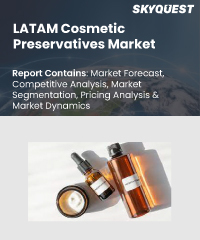
Report ID: SQMIR15G2092

Report ID:
SQMIR15G2092 |
Region:
Regional |
Published Date: February, 2024
Pages:
157
|
Tables:
63 |
Figures:
75
Drivers
Restraints
Our industry expert will work with you to provide you with customized data in a short amount of time.
REQUEST FREE CUSTOMIZATIONLATAM Cosmetic Preservatives Market size was valued at USD 3.87 billion in 2021 and is poised to grow from USD 4.13 billion in 2022 to USD 6.50 billion by 2030, growing at a CAGR of 6.7% in the forecast period (2023-2030).
In addition to regional and specialty manufacturers, the LATAM cosmetic preservatives market is home to a wide range of competitors, including international chemical corporations like BASF and DowDuPont. Because of the strict regulations and the increasing need for natural and environmentally friendly preservatives, there is strong competition. To improve market presence, key methods include mergers and acquisitions, strategic alliances, and new product creation. In the Latin American cosmetics market, leading competitors prioritize providing a broad range of preservative solutions to fulfill the needs of different customers while also putting an emphasis on sustainability and safety to satisfy changing consumer preferences. 'BASF SE - Germany', 'Dow Chemical Company - United States', 'Lonza Group - Switzerland', 'Ashland Holdings Inc. - United States', 'Symrise AG - Germany', 'Clariant AG - Switzerland', 'DSM Nutritional Products - Netherlands', 'Sharon Laboratories - Israel', 'Chemipol - Spain', 'Akema Fine Chemicals - Italy', 'Salicylates and Chemicals Pvt. Ltd. - India', 'Brenntag Specialties, Inc. - United States', 'Galaxy Surfactants Ltd. - India', 'Innospec Inc. - United States', 'Sharon Laboratories - Israel', 'Kumar Organic Products Limited - India', 'Schülke & Mayr GmbH - Germany', 'Evonik Industries AG - Germany', 'KLK Oleo - Malaysia', 'Kemin Industries, Inc. - United States'
Increasing Consumer Awareness about Product Safety: One major driver has been customers' growing knowledge of the significance of product safety and the possible health hazards connected to microbiological contamination in cosmetics. The market for natural and alternative preservatives is being driven by consumers' desire for products with longer shelf life and fewer preservatives they believe to be hazardous.
Demand for Natural and Eco-Friendly Preservatives: Concerns regarding the safety and environmental effects of the items they use have grown among consumers in the cosmetics sector. As a result, there is an increasing need for natural and environmentally friendly preservatives in cosmetic goods. Key developments could be the replacement of conventional synthetic preservatives like parabens and formaldehyde-releasing compounds with plant-based or organic alternatives, such as essential oils, herbal extracts, and organically produced antibacterial agents.
LATAM's biggest cosmetic preservatives market segment is Mexico, followed closely by Argentina and Brazil. The projected CAGR for the LATAM cosmetic preservatives market is ascertained to be fixed at 6% for the next 5 years. The growing need for cosmetics in these countries and rising consumer disposable income is propelling market expansion.
Want to customize this report? This report can be personalized according to your needs. Our analysts and industry experts will work directly with you to understand your requirements and provide you with customized data in a short amount of time. We offer $1000 worth of FREE customization at the time of purchase.

Report ID: SQMIR15G2092